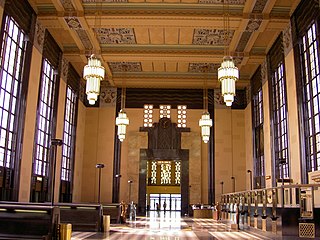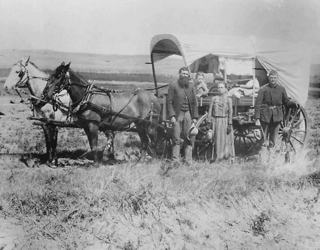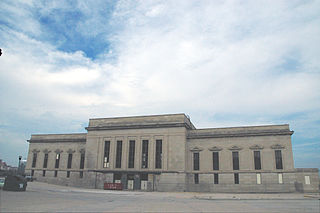Related Research Articles

North America's first transcontinental railroad was a 1,911-mile (3,075 km) continuous railroad line constructed between 1863 and 1869 that connected the existing eastern U.S. rail network at Council Bluffs, Iowa, with the Pacific coast at the Oakland Long Wharf on San Francisco Bay. The rail line was built by three private companies over public lands provided by extensive US land grants. Building was financed by both state and US government subsidy bonds as well as by company-issued mortgage bonds. The Western Pacific Railroad Company built 132 miles (212 km) of track from the road's western terminus at Alameda/Oakland to Sacramento, California. The Central Pacific Railroad Company of California (CPRR) constructed 690 miles (1,110 km) east from Sacramento to Promontory Summit, Utah Territory. The Union Pacific Railroad (UPRR) built 1,085 miles (1,746 km) from the road's eastern terminus at the Missouri River settlements of Council Bluffs and Omaha, Nebraska, westward to Promontory Summit.

Buffalo County is a county located in the U.S. state of Nebraska in the Midwestern United States. As of the 2020 United States Census, the population was 50,084, making it Nebraska's fifth-most populous county. Its county seat is Kearney. The county was created in 1855 and was organized in 1870. It was named after the once-prevalent buffalo herds of the Great Plains.

Pleasanton is a village in Buffalo County in the state of Nebraska in the Midwestern United States. At the 2010 census, its population was 341.

Central City is a city and the county seat of Merrick County, Nebraska, United States. It is part of the Grand Island, Nebraska Metropolitan Statistical Area. The population was 2,934 at the 2010 census.

The Chicago and North Western was a Class I railroad in the Midwestern United States. It was also known as the "North Western". The railroad operated more than 5,000 miles (8,000 km) of track at the turn of the 20th century, and over 12,000 miles (19,000 km) of track in seven states before retrenchment in the late 1970s. Until 1972, when the employees purchased the company, it was named the Chicago and North Western Railway.

Niles Canyon is a canyon in the San Francisco Bay Area formed by Alameda Creek, known for its heritage railroad and silent movie history. The canyon is largely in an unincorporated area of Alameda County, while the western portion of the canyon lies within the city limits of Fremont and Union City. The stretch of State Route 84 known as Niles Canyon Road traverses the length of the canyon from the Niles district of Fremont to the unincorporated town of Sunol. Two railroads also follow the same route down the canyon from Sunol to Niles: the old Southern Pacific track along the north side, now the Niles Canyon Railway, and the newer Union Pacific track a little to the south. At the west end of the canyon are the ruins of the Vallejo Flour Mill, which dates to 1853.

The Chicago, St. Paul, Minneapolis and Omaha Railway or Omaha Road was a railroad in the U.S. states of Nebraska, Iowa, Minnesota, Wisconsin and South Dakota. It was incorporated in 1880 as a consolidation of the Chicago, St. Paul and Minneapolis Railway and the North Wisconsin Railway. The Chicago and North Western Railway (C&NW) gained control in 1882. The C&NW leased the Omaha Road in 1957 and merged the company into itself in 1972. Portions of the C. St. P. M. and O. are part of the Union Pacific Railroad network. This includes main lines from Wyeville, Wisconsin, to St. Paul, Minnesota, and St. Paul to Sioux City, Iowa.

The Central Branch Union Pacific Railroad was a railroad in the U.S. state of Kansas. Originally planned as a line from Atchison west into Colorado, and given federal land grants by the Pacific Railway Act of 1862 as one of the branches of the Union Pacific Railroad, it was left with a hanging end at Waterville, Kansas, when the Union Pacific Railway, Eastern Division, with which it was to connect, changed its route. The line was acquired by the Union Pacific through a stock purchase by Jay Gould and leased to the Missouri Pacific Railroad in 1880. In 1909 the Central Branch was merged into the Missouri Pacific; the latter company came back into the Union Pacific system in 1982. In 1991 the remaining trackage west of Frankfort was leased to the Kyle Railroad.
The Midland Pacific Railway was a railroad operating in the Nebraska counties of Lancaster, Nemaha, Otoe, Seward, and York.

The Union Station, at 801 South 10th Street in Omaha, Nebraska, known also as Union Passenger Terminal, is "one of the finest examples of Art Deco architecture in the Midwest". Designated an Omaha Landmark in 1978, it was listed as "Union Passenger Terminal" on the National Register of Historic Places in 1971, and was designated a National Historic Landmark in 2016. The Union Station is also a contributing property to the Omaha Rail and Commerce Historic District. It was the Union Pacific's first Art Deco railroad station, and the completion of the terminal "firmly established Omaha as an important railroad terminus in the Midwest".

The history of the U.S. state of Nebraska dates back to its formation as a territory by the Kansas–Nebraska Act, passed by the United States Congress on May 30, 1854. The Nebraska Territory was settled extensively under the Homestead Act of 1862 during the 1860s, and in 1867 was admitted to the Union as the 37th U.S. state. The Plains Indians are the descendants of a long line of succeeding cultures of indigenous peoples in Nebraska who occupied the area for thousands of years before European arrival and continue to do so today.

Transportation in Omaha, Nebraska, includes most major modes, such as pedestrian, bicycle, automobile, bus, train and airplane. While early transportation consisted of ferries, stagecoaches, steamboats, street railroads, and railroads, the city's transportation systems have evolved to include the Interstate Highway System, parklike boulevards and a variety of bicycle and pedestrian trails. The historic head of several important emigrant trails and the First transcontinental railroad, its center as a national transportation hub earned Omaha the nickname "Gate City of the West" as early as the 1860s.

Railroads in Omaha, Nebraska, have been integral to the growth and development of the city, the state of Nebraska, the Western United States and the entire United States. The convergence of many railroad forces upon the city was by happenstance and synergy, as none of the Omaha leaders had a comprehensive strategy for bringing railroads to the city.
Augustus Kountze was an American businessman based in Omaha, Nebraska, Kountze, Texas and New York City. He founded a late 19th-century national banking dynasty along with his brothers Charles, Herman and Luther.
The Omaha Belt Line was a 15-mile (24 km) long railroad that circumnavigated Omaha, Nebraska, starting in 1885. The organization behind the line, called the Omaha Belt Railway, was incorporated two years earlier, in 1883. Carrying passengers and cargo, the original line was operated by the Missouri Pacific Railroad, with the first line from the Sarpy County line into Downtown Omaha.

The Overland Route was a train route operated jointly by the Union Pacific Railroad and the Central Pacific Railroad / Southern Pacific Railroad, between Council Bluffs, Iowa / Omaha, Nebraska, and the San Francisco Bay Area, over the grade of the first transcontinental railroad which had been opened on May 10, 1869. Passenger trains that operated over the line included the Overland Flyer, later renamed the Overland Limited, which also included a connection to Chicago. Although these passenger rail trains are no longer in operation, the Overland Route remains a common name for the line from Northern California to Chicago, now owned entirely by the Union Pacific. Although now primarily used for freight, a few portions still provide the route for the California Zephyr passenger train.
The Cheyenne and Northern Railway was a railroad in the U.S. state of Wyoming. The railroad was incorporated in 1886 to build a line from Cheyenne, Wyoming into northern Wyoming and Montana. The line extended 125 miles (201 km) to Wendover on the North Platte River. It was absorbed by Union Pacific Railroad subsidiary Union Pacific, Denver and Gulf Railway and later became part of the Colorado and Southern Railway when the Union Pacific went into receivership.

The Illinois Central Missouri River Bridge, also known as the IC Bridge or the East Omaha Bridge, is a rail through truss double swing bridge across the Missouri River connecting Council Bluffs, Iowa, with Omaha, Nebraska. It is owned by the Canadian National Railway and is closed to all traffic. At 521 feet long, the second version of the bridge was the longest swing bridge in the world from when it was completed in 1903 through 1915. In 1975 it was regarded as the third longest swing bridge.

Yocemento is an unincorporated community in Big Creek Township, Ellis County, Kansas, United States. The settlement lies across the banks of Big Creek against the base of bluffs capped by massive limestone blocks, in which lies the 20th-century origin of the community.
The Kansas and Arkansas Valley Railway (“K&AV”) was owner of 170.64 miles of single track, standard gauge steam railroad line, consisting of a 164.63 mile mainline from a junction near Van Buren, Arkansas through Oklahoma to Coffeyville, Kansas, with branch lines of 6.01 miles. It began operations in 1888 and sold its property to the St. Louis, Iron Mountain and Southern Railway in 1909.
References
- 1 2 Howell, A.S. (1981) "Sartoria, a little ghost town" Archived October 24, 2007, at the Wayback Machine , Buffalo Tales. Buffalo County Historical Society. Retrieved 8/22/07.
- ↑ Union Pacific Railroad Company. (1886) The Union Pacific Railway and Auxiliary Companies. Statistics Relating to Annual Meetings. p. 89.
- ↑ Howell, A. (1978) "Railroads in Buffalo County" Archived August 7, 2007, at the Wayback Machine , Buffalo Tales. Buffalo County Historical Society. Retrieved 8/22/07.
- ↑ "Miller resident fighting to clean up cemetery", Nebraska State Genealogical Society Journals. Retrieved 8/22/07.